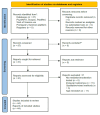Mediating and Moderating Mechanisms in the Relationship Between Social Media Use and Adolescent Aggression: A Scoping Review of Quantitative Evidence
- PMID: 40558841
- PMCID: PMC12192510
- DOI: 10.3390/ejihpe15060098
Mediating and Moderating Mechanisms in the Relationship Between Social Media Use and Adolescent Aggression: A Scoping Review of Quantitative Evidence
Abstract
Adolescents' pervasive use of social media has been increasingly linked to aggression, including cyberbullying and hostile online interactions. While this association is well documented, the psychological and contextual mechanisms that mediate or moderate it remain unclear. This scoping review maps quantitative evidence on mediators and moderators between social media use and aggression among adolescents. A comprehensive search using ProQuest's Summon platform was conducted across PsycINFO, Scopus, PubMed, and Web of Science, following the PRISMA 2020 guidelines. Eligible studies, published between January 2020 and March 2025, included adolescents aged 11-18 and reported at least one statistical mediation or moderation analysis. Forty-four studies from 19 countries (N > 90,000) were thematically synthesized. Key mediators included problematic use, moral disengagement, depression, attention-seeking, and risky digital behaviors. Moderators included gender, body satisfaction, cultural setting, school type, and family attachment. Most of the studies used structural equation modeling or PROCESS macro, although cross-sectional designs predominated. Limitations included reliance on self-reports and inconsistent social media measures. The findings suggest that social media-aggression links are indirect and shaped by emotional, cognitive, and ecological factors. Multi-level interventions targeting digital literacy, moral reasoning, and resilience are needed. This review was not registered and received no external funding.
Keywords: adolescent aggression; mediators; moderators; social media use.
Conflict of interest statement
The authors declare no conflicts of interest.
Figures
Similar articles
-
Eliciting adverse effects data from participants in clinical trials.Cochrane Database Syst Rev. 2018 Jan 16;1(1):MR000039. doi: 10.1002/14651858.MR000039.pub2. Cochrane Database Syst Rev. 2018. PMID: 29372930 Free PMC article.
-
Incentives for preventing smoking in children and adolescents.Cochrane Database Syst Rev. 2017 Jun 6;6(6):CD008645. doi: 10.1002/14651858.CD008645.pub3. Cochrane Database Syst Rev. 2017. PMID: 28585288 Free PMC article.
-
Interventions for preventing abuse in the elderly.Cochrane Database Syst Rev. 2016 Aug 16;2016(8):CD010321. doi: 10.1002/14651858.CD010321.pub2. Cochrane Database Syst Rev. 2016. PMID: 27528431 Free PMC article.
-
Technological aids for the rehabilitation of memory and executive functioning in children and adolescents with acquired brain injury.Cochrane Database Syst Rev. 2016 Jul 1;7(7):CD011020. doi: 10.1002/14651858.CD011020.pub2. Cochrane Database Syst Rev. 2016. PMID: 27364851 Free PMC article.
-
Psychological interventions for adults who have sexually offended or are at risk of offending.Cochrane Database Syst Rev. 2012 Dec 12;12(12):CD007507. doi: 10.1002/14651858.CD007507.pub2. Cochrane Database Syst Rev. 2012. PMID: 23235646 Free PMC article.
References
-
- Aljasir S. A., Alsebaei M. O. Cyberbullying and cybervictimization on digital media platforms: The role of demographic variables and parental mediation strategies. Humanities and Social Sciences Communications. 2022;9(1):320. doi: 10.1057/s41599-022-01318-x. - DOI
-
- Alsebaei M.-O., Aljasir S. A. Parenting in the digital age: Mediation strategies as a preventive factor against cyberbullying on social media among saudi parents. Communication & Society. 2024;37(4):143–162.
-
- Bakan Kıraç İ., Sahmurova A., Duradoni M., Guazzini A., Gursesli M. C. The shield of resilience: Mediating the effects of internet addiction on adolescent anger control. Advances in Public Health. 2024;2024(1):5519519. doi: 10.1155/adph/5519519. - DOI
Publication types
LinkOut - more resources
Full Text Sources


